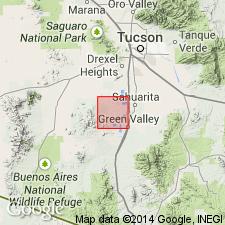
- Usage in publication:
-
- Helmet fanglomerate*
- Modifications:
-
- Original reference
- Dominant lithology:
-
- Conglomerate
- AAPG geologic province:
-
- Basin-and-Range province
Summary:
Pg. 77, 89, pl. 1. Helmet fanglomerate. Deformed postmineralization formation. Predominantly coarse ill-sorted and ill-bedded conglomerate characterized by angular pebbles, cobbles, and boulders in silty matrix. Intercalated are lava flows of porphyritic andesites, thin beds of rhyolitic tuff and tuffaceous sediments, and lentils and tongues of monolithographic breccia. Thickness at least 10,000 feet. Along northwest side, in depositional contact on rhyolitic tuff and probably Cretaceous(?) rocks; to northeast, extends beneath Quaternary alluvium; other boundaries are fault contacts with Precambrian granite. Paleozoic sedimentary rocks, and granodiorite. No fossils; tentative correlations suggest that fanglomerate may be of early Miocene age.
Type section not designated. Most continuous exposures are along north-trending line from point 0.75 mi southeast of Helmet Peak to point 1.25 mi north-northwest of Twin Buttes village, Pima mining district, Pima Co., southwestern AZ.
Source: US geologic names lexicon (USGS Bull. 1200, p. 1728-1729).
For more information, please contact Nancy Stamm, Geologic Names Committee Secretary.
Asterisk (*) indicates published by U.S. Geological Survey authors.
"No current usage" (†) implies that a name has been abandoned or has fallen into disuse. Former usage and, if known, replacement name given in parentheses ( ).
Slash (/) indicates name conflicts with nomenclatural guidelines (CSN, 1933; ACSN, 1961, 1970; NACSN, 1983, 2005, 2021). May be explained within brackets ([ ]).

